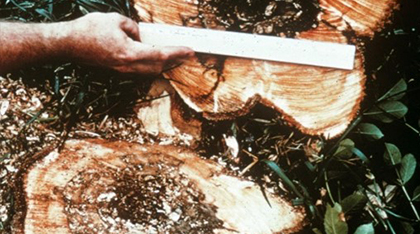
PLANT PEST
Subterranean termites
(exotic species)
Exotic to Australia
Features: Two species of soil-dwelling termites that attack
both dead and living wood, including commercial timber,
structural timber and forest trees.
Where they're from: China, Japan, South Africa, Virgin
Islands, Marshall Islands, Cayman Islands, south-eastern
United States, Taiwan, Brazil, the Philippines, Caribbean
Islands, Hawaii, India, Indonesia, Myanmar, Cambodia,
Vietnam and Fiji.
How they spreads: Importation of infested wood;
local spread by tunnelling and flying.
At risk: Plantation forests, structural timber, street trees
and urban parks.
These species of termites attack living trees as well as timber.
Experts are needed to identify the exotic species.
Credit: Scott Bauer, USDA Agricultural Research Service,
Bugwood.org
Keep it out
Two subterranean termites, the Formosan termite and Asian subterranean termite (Coptotermes formosanus and Coptotermes gestroi) are social insects which cause extensive damage to both living and dead wood. This means that they can cause structural damage to homes and buildings as well as attack live trees. They hollow out the heartwood of a mature tree or structural timber, replacing it with nest material and soil.
Subterranean termites, as the name suggests, live in an underground nest and excavate tunnels to transport, store brood (eggs) and forage for food. Their colonies can be huge, with several million termites that constantly move back and forth along these tunnels. They live in honeycomb-like nests a metre or more across and build new nests up to 100m away. With numbers such as these, the subterranean termite can cause significant environmental and economic damage.
The Formosan termite is sometimes called the super termite, because of the huge colonies it builds, and its ability to cause extensive damage to a timber structure in under three months. In 2002, it was estimated that it costs over $1 billion annually in the USA to prevent, treat and repair damage caused by this insect. In New Orleans, 30-50 per cent of the city's 4,000 historic oak trees are believed to be infested. The Formosan termite is also very hard to kill and has never been eradicated once becoming established in a new area.
Any large wooden articles or infested soil could bring subterranean termites to Australia. This includes crates, pallets or shipping containers and wooden posts. Winged forms of the termites, called alates, can swarm from boats arriving in ports to infest nearby buildings.
As well as posing a threat to buildings, these termites pose a risk to plantation forests, landscape and endemic trees in Australia.
Importing goods
To keep exotic termites out of Australia, never ignore Australia’s strict biosecurity rules.
Import shipments may need to be treated and certified, so before you import, check our Biosecurity Import Conditions system (BICON).
What to look for
- Subterranean termites will be inside trees, timber or soil.
- Look for tubes —half to one cm in diameter—that termites construct to get from the soil to the timber of a building or to the trunk of a tree.
- In houses, nests can be found in walls and near a water source, like a sink.
- Tap wood to find any hidden damage and look for blistered wood surface damage and debris.
- In trees, look for termites around ground level or below.
- Tree stumps and logs can also be infested.
- In general, these exotic species have a pear-shaped head that is narrow at the front, which is different to existing Australian species; however, an expert is needed to precisely identify a species.


Where to look
Importers
Importation of infested plants, timber items and conveyances (such as yachts with wooden components) are the most likely ways that subterranean termites would make it to Australia. Tap wooden items to check for structural damage and nests.
Foresters and residents
Keep an eye out for any unusual termite activity in plantation trees, tree stumps, dead branches, timber parts of homes and buildings and any large timber items.
What to do
If you think you’ve found an exotic termite species:
- contain the material without disturbing it (this may be as simple as closing the doors on a shipping container or wrapping furniture in plastic wrap)
- collect some of the insects and debris if possible.
Read the detail

